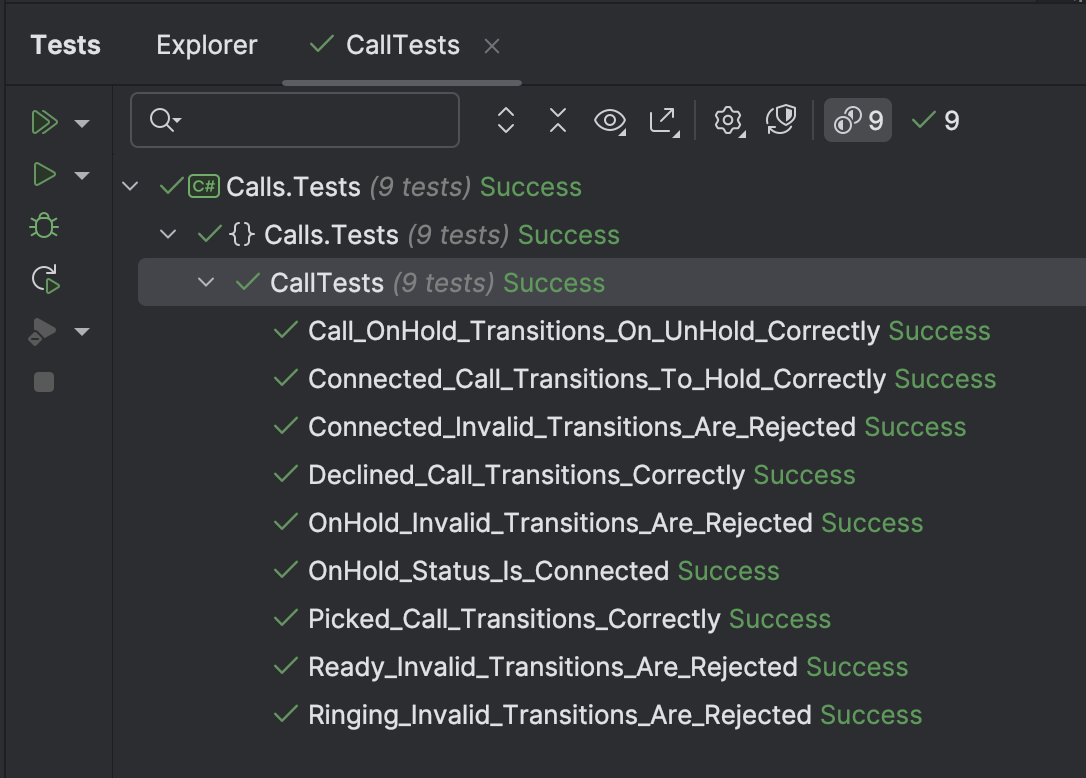Using State Machines In .NET - Part 5 - Using Complex & Nested States
[C#, .NET, Stateless, StarLibrary]
This is Part 5 of a series on using State Machines to express complex logic.
- Using State Machines In .NET - Part 1 - Introduction
- Using State Machines In .NET - Part 2 - Basic Usage
- Using State Machines In .NET - Part 3 - Setting Initial State
- Using State Machines In .NET - Part 4 - Using Multiple Triggers
- Using State Machines In .NET - Part 5 - Using Complex & Nested States (This Post)
- Using State Machines In .NET - Part 6 - Firing Events On State Change
- Using State Machines In .NET - Part 7 - Conditional State Transitions
- Using State Machines In .NET - Part 8 - Firing Events Before State Change
- Using State Machines In .NET - Part 9 - Calling Asynchronous Methods
- Using State Machines In .NET - Part 10 - Generating State Diagrams
- Using State Machines In .NET - Part 11 - Logic Based On How A State Was Transitioned
- Using State Machines In .NET - Part 12 - State Activation & Entry
Our last post examined how to use multiple triggers in your logic.
This post will look at how to model complex & nested states.
We will use an easily understood domain - a telephone Call for this example.
Callis initially in theReadystate- A
Dialtrigger transitions toRinging - A
Ringingcall can be picked up, transitioning toConnected - It can also be
HungUp, transitioning toReady - While
Connected, a triggerHoldcan transitiontoOnHold - It can also transition to
Readyby the triggerHangUp - While
OnHold,it can transition back toConnectedfrom theUnHoldtrigger - It can also trigger back to
Readyby theHangUptrigger.
The state transition diagram is as follows:

The code for this is as follows:
First, the statuses:
public enum Status
{
Ready,
Ringing,
Connected,
OnHold,
}
Then, the triggers:
public enum Trigger
{
Dial,
PickUp,
HangUp,
Hold,
UnHold
}
Then, the Call class:
public sealed class Call
{
private readonly StateMachine<Status, Trigger> _stateMachine;
public string Graph => UmlDotGraph.Format(_stateMachine.GetInfo());
public Status CurrentStatus => _stateMachine.State;
public Call()
{
// Create the state machine, and set the initial state as red
_stateMachine = new StateMachine<Status, Trigger>(Status.Ready);
//
// Configure state machine
//
_stateMachine.Configure(Status.Ready)
.Permit(Trigger.Dial, Status.Ringing);
_stateMachine.Configure(Status.Ringing)
.Permit(Trigger.PickUp, Status.Connected)
.Permit(Trigger.HangUp, Status.Ready);
_stateMachine.Configure(Status.Connected)
.Permit(Trigger.Hold, Status.OnHold)
.Permit(Trigger.HangUp, Status.Ready);
_stateMachine.Configure(Status.OnHold)
.Permit(Trigger.UnHold, Status.Connected)
.Permit(Trigger.HangUp, Status.Ready);
}
public void Dial()
{
_stateMachine.Fire(Trigger.Dial);
}
public void HangUp()
{
_stateMachine.Fire(Trigger.HangUp);
}
public void PickUp()
{
_stateMachine.Fire(Trigger.PickUp);
}
public void Hold()
{
_stateMachine.Fire(Trigger.Hold);
}
public void UnHold()
{
_stateMachine.Fire(Trigger.UnHold);
}
}
Finally, some tests to ensure everything is ok.
public class CallTests
{
[Fact]
public void Declined_Call_Transitions_Correctly()
{
var call = new Call();
call.CurrentStatus.Should().Be(Status.Ready);
call.Dial();
call.CurrentStatus.Should().Be(Status.Ringing);
call.HangUp();
call.CurrentStatus.Should().Be(Status.Ready);
}
[Fact]
public void Picked_Call_Transitions_Correctly()
{
var call = new Call();
call.CurrentStatus.Should().Be(Status.Ready);
call.Dial();
call.CurrentStatus.Should().Be(Status.Ringing);
call.PickUp();
call.CurrentStatus.Should().Be(Status.Connected);
call.HangUp();
call.CurrentStatus.Should().Be(Status.Ready);
}
[Fact]
public void Connected_Call_Transitions_To_Hold_Correctly()
{
var call = new Call();
call.Dial();
call.PickUp();
call.Hold();
call.CurrentStatus.Should().Be(Status.OnHold);
}
[Fact]
public void Call_OnHold_Transitions_On_UnHold_Correctly()
{
var call = new Call();
call.Dial();
call.PickUp();
call.Hold();
call.UnHold();
call.CurrentStatus.Should().Be(Status.Connected);
}
[Fact]
public void Ready_Invalid_Transitions_Are_Rejected()
{
var call = new Call(Status.Ready);
var ex = Record.Exception(() => call.PickUp());
ex.Should().BeOfType<InvalidOperationException>();
ex = Record.Exception(() => call.Hold());
ex.Should().BeOfType<InvalidOperationException>();
ex = Record.Exception(() => call.UnHold());
ex.Should().BeOfType<InvalidOperationException>();
ex = Record.Exception(() => call.HangUp());
ex.Should().BeOfType<InvalidOperationException>();
}
[Fact]
public void Ringing_Invalid_Transitions_Are_Rejected()
{
var call = new Call(Status.Ringing);
var ex = Record.Exception(() => call.Dial());
ex.Should().BeOfType<InvalidOperationException>();
ex = Record.Exception(() => call.UnHold());
ex.Should().BeOfType<InvalidOperationException>();
ex = Record.Exception(() => call.Hold());
ex.Should().BeOfType<InvalidOperationException>();
}
[Fact]
public void Connected_Invalid_Transitions_Are_Rejected()
{
var call = new Call(Status.Connected);
var ex = Record.Exception(() => call.PickUp());
ex.Should().BeOfType<InvalidOperationException>();
ex = Record.Exception(() => call.Dial());
ex.Should().BeOfType<InvalidOperationException>();
}
[Fact]
public void OnHold_Invalid_Transitions_Are_Rejected()
{
var call = new Call(Status.OnHold);
var ex = Record.Exception(() => call.PickUp());
ex.Should().BeOfType<InvalidOperationException>();
ex = Record.Exception(() => call.Dial());
ex.Should().BeOfType<InvalidOperationException>();
}
}
So far, so good.
The challenge comes when we need to get the status of a call that is OnHold.
Much as it is OnHold, a call that is OnHold is also Connected.
We can configure the state machine to reflect this:
_stateMachine.Configure(Status.OnHold)
.SubstateOf(Status.Connected)
.Permit(Trigger.UnHold, Status.Connected)
.Permit(Trigger.HangUp, Status.Ready);
We can then examine whether a call is Connected by using the IsInState method. Here, we have added a computed property to the Call class.
public bool IsConnected => _stateMachine.IsInState(Status.Connected);
Of importance is the fact that while we can interrogate the IsConnected property, the actual state is still OnHold.
A test can ensure this is working.
[Fact]
public void OnHold_Status_Is_Connected()
{
var call = new Call(Status.Ready);
call.Dial();
call.PickUp();
call.IsConnected.Should().BeTrue();
call.Hold();
call.CurrentStatus.Should().Be(Status.OnHold);
call.IsConnected.Should().BeTrue();
}

In the next post, we will look at how to use events to react to state changes.
TLDR
States can be configured to be SubStates of other states, so nested relationships can be captured.
The code is in my GitHub.
Happy Hacking!